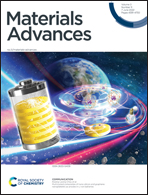Photocatalytic conversion of arylboronic acids to phenols by a new 2D donor–acceptor covalent organic framework†
Abstract
Covalent organic frameworks (COFs) are a kind of promising crystalline material for photocatalytic organic conversion. The introduction of electron donor–acceptor (D–A) units into its structure can reasonably adjust the photoelectric properties and energy bandwidth of COFs. In this research, we designed and synthesized a two-dimensional (2D) D–A type COF (BTT-BTDDA-COF) based on alternating connections of benzotrithiophene (BTT) and 4,4’-(2,1,3-benzothiadiazole-4,7-diyl)dianiline (BTDDA) units, with a wide visible light absorption range and good photoelectric response characteristics. In the photocatalytic conversion of arylboronic acid to phenol, BTT-BTDDA-COF exhibits high catalytic activity, wide substrate applicability and good recoverability. The high-efficiency photocatalytic activity of BTT-BTDDA-COF is reasonably attributed to the electron push–pull effect between the donor and acceptor units, which significantly improves the transfer and separation of carriers, which leads to the expansion of the visible light absorption range. The above results show the practicability of COFs material design and provide a new idea for the application of the new D–A COF catalyst in photocatalytic organic conversion.



 Please wait while we load your content...
Please wait while we load your content...